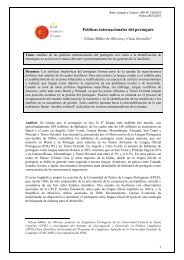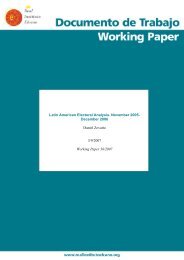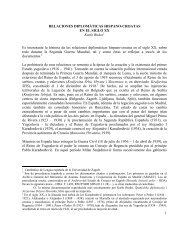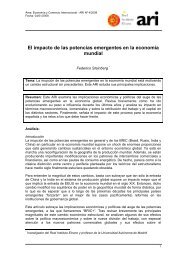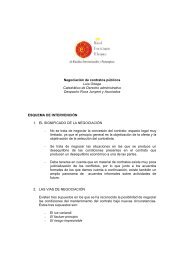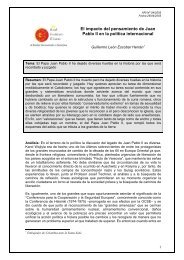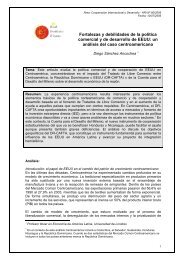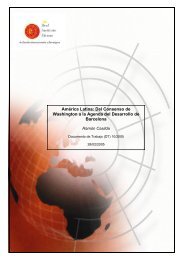Spain and the United States - Real Instituto Elcano
Spain and the United States - Real Instituto Elcano
Spain and the United States - Real Instituto Elcano
You also want an ePaper? Increase the reach of your titles
YUMPU automatically turns print PDFs into web optimized ePapers that Google loves.
Exhibit 7.2 Competitiveness Factors*<br />
LOOKING AHEAD 127<br />
The current account deficit is partly due to higher oil prices <strong>and</strong> <strong>the</strong> euro’s<br />
appreciation, but, in <strong>the</strong> words of Jaime Caruana, <strong>the</strong> governor of <strong>the</strong> Bank of<br />
<strong>Spain</strong>, “<strong>the</strong>se factors do not suffice to explain ei<strong>the</strong>r <strong>the</strong> scale of <strong>the</strong> deficit or<br />
<strong>the</strong> speed at which it has widened, <strong>and</strong> <strong>the</strong>y should not <strong>the</strong>refore conceal <strong>the</strong><br />
existence of a genuine deterioration relating to <strong>the</strong> losses in competitiveness<br />
built up in recent years.” 3 Although <strong>Spain</strong> belongs to a monetary union, which<br />
means “<strong>the</strong>re is no danger of a burgeoning external deficit generating financial<br />
or foreign-exchange pressures that <strong>the</strong>n trigger a sharp adjustment in <strong>the</strong><br />
economy, since fundamental variables, such as <strong>the</strong> interest rate <strong>and</strong> exchange<br />
rate, are determined at <strong>the</strong> area-wide level”, this does not signify that “<strong>the</strong><br />
economy is immune to competitiveness problems. On <strong>the</strong> contrary, when a<br />
large external deficit emerges in a monetary union as a result of an economy’s<br />
difficulties in competing, a very costly dilemma may arise: nominal costs are<br />
ei<strong>the</strong>r adjusted head-on, or <strong>the</strong> loss of competitiveness will check <strong>the</strong><br />
generation of value added <strong>and</strong> job creation.”<br />
<strong>Spain</strong>’s ailing competitiveness, particularly in labour costs (see Exhibit<br />
7.3), an area where <strong>the</strong> country cannot compete on this basis alone as it is no<br />
longer a low-cost manufacturer, has led more than 40 multinationals, as well as<br />
some Spanish companies, to pull out of <strong>Spain</strong> since 2002 <strong>and</strong> shift <strong>the</strong>ir<br />
production to o<strong>the</strong>r countries, principally <strong>the</strong> new EU members in eastern <strong>and</strong><br />
central Europe but also China. 4 Several US companies have partially or fully<br />
relocated, including Lear, DuPont, Levi's <strong>and</strong> Hewlett Packard. In 2005, <strong>the</strong><br />
US-based TRW moved production of airbags <strong>and</strong> seat belts from Burgos to<br />
Pol<strong>and</strong> to save costs, three years after it closed ano<strong>the</strong>r plant near Barcelona.<br />
Although still an important vehicle manufacturing centre in Europe (Ford,<br />
General Motors <strong>and</strong> DaimlerChrysler are all in <strong>Spain</strong>), <strong>the</strong> production of parts<br />
3. See pp. 10-16 of his address to <strong>the</strong> Bank of <strong>Spain</strong>’s Governing Council on June 10, 2005<br />
(www.bde.es/prensa/intervenpub/gobernador/100605e.pdf).<br />
4. See “Factory Closures Hit Unskilled Workers”, by Mark Mulligan in <strong>the</strong> special report on <strong>Spain</strong> in <strong>the</strong><br />
Financial Times of June 14, 2005.



